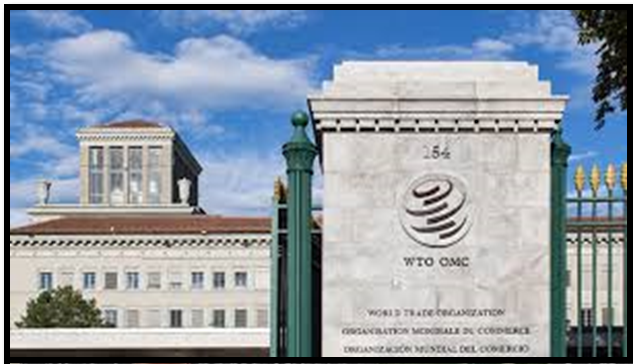RETHINKING INDIA’S TRADE POLICY BARRIERS
Syllabus:
- GS-3- Free and Fair Trade , WTO , Implications and Challenges for India , Related Solutions
Focus :
- The article focuses on India’s counterproductive trade policy barriers, particularly high tariffs on electronic components and textiles, and the need for a strategic overhaul. It highlights the Confederation of Indian Industry’s recommendations for reducing tariffs, encouraging technology transfers, and forming strategic international partnerships to enhance global competitiveness and economic growth.
Source - ET
Introduction: Lessons from the Past
- In June 1985, trade economist Jagdish Bhagwati submitted an article to the New York Times, detailing the Rajiv Gandhi government’s industrial deregulation.
- A key aspect of this deregulation was “broad-banding,” a policy allowing companies to diversify their product lines without government permission.
- The concept baffled the New York Times editor, who couldn’t believe any government would restrict such diversification.
- This historical anecdote underscores a persistent theme in India’s economic policy: the struggle between regulation and liberalization.
The Self-Reliant India Fantasy
- The 21st-century equivalent of restrictive policies is India’s pursuit of self-reliance.
- Over the past decade, India has raised tariffs on more than 3,000 items, expecting export growth to follow.
- However, this approach contradicts the successful export-led growth seen in East Asia.
- This week, the Confederation of Indian Industry (CII) urged a return to more rational trade and industrial policies.
- It highlighted how high tariffs on electronic components disadvantage India compared to competitors like Vietnam.
- CII’s study revealed that tariffs ranging from 10% to 27.5% on electronic components negate the benefits of productivity-linked incentives and hinder localization efforts.
The Cost of High Tariffs
- If the World Trade Organization allowed companies to sue their governments over tariff and non-tariff barriers, Indian exporters would have a strong case.
- The CII’s 50-page study calls for reversing measures taken after the 2020 border conflict with China, advocating for a “non-restrictive approach” towards technology transfers, foreign direct investment (FDI) from China, and easing the movement of Chinese skilled manpower.
- The report points out that openness to component imports was crucial for China and Vietnam in becoming export powerhouses. China, for instance, imports over 40% of its electronic components, recognizing the necessity of high-end components from countries like Korea and Taiwan.
About WTO
|
A Calibrated Approach to Trade Liberalization
- While the CII advocates for liberalizing trade with China, a more nuanced approach is necessary.
- The developed world is also seeking to reduce its dependence on China, and India, having faced direct aggression from Beijing, must tread carefully.
- The goal should be to build strong links with other countries, particularly Taiwan.
- India’s trade deficit with China reached $85 billion in the last financial year, doubling over four years, highlighting the need for a strategic rethink.
The Failure of Self-Reliance
- India’s protectionist trade policies have been counterproductive.
- If adjusted for inflation, India’s annual merchandise exports would reveal a decline.
- The Global Trade Research Initiative reports that in 2023, China’s garment exports were $11.4 billion, Vietnam’s were $82 billion, while India’s were just under $15 billion and declining.
- Despite ambitious targets set by Indian ministries, such as $100 billion in textile exports by 2030 and $600 billion by 2047, high tariffs on essential materials like viscose and polypropylene cripple the garment industry.
Case Study: Electronics and Apparel
- High tariffs on electronic components and textiles illustrate the broader issue.
- My recent purchases from Marks & Spencer India, including T-shirts and trousers, were made in Bangladesh and Vietnam due to India’s high tariffs.
- This scenario is not unique; many Indian consumers face similar choices, undermining the self-reliance narrative.
- To truly support self-reliance, India needs to lower tariffs and encourage local production without isolating itself from global supply chains.
Policy Recommendations
- Reduce Tariffs: Lowering tariffs on electronic components and textiles would make Indian products more competitive globally. This move would also attract foreign investment and technology transfers, fostering local manufacturing capabilities.
- Engage in Free Trade Agreements (FTAs): Joining significant regional FTAs would integrate India into global supply chains, enhancing export opportunities. Participation in FTAs with countries like Taiwan, Korea, and ASEAN members could provide a much-needed boost to various industries.
- Promote Technology Transfers and FDI: Encouraging technology transfers and FDI, especially from technologically advanced nations, would help India build domestic capabilities. Easing restrictions on Chinese FDI and skilled manpower, while managing security concerns, could also be beneficial.
- Focus on Strategic Partnerships: Building stronger trade and investment ties with countries like Taiwan and South Korea would reduce dependence on China and diversify India’s economic relationships. These partnerships could also facilitate the transfer of critical technologies.
- Rethink Protectionist Measures: Protectionist policies should be reassessed to balance national security concerns with economic growth. Strategic, rather than blanket, protectionism can protect critical industries while promoting overall economic development.
- Encourage Domestic Innovation: Investing in domestic research and development (R&D) and supporting startups in key sectors can reduce reliance on imports over time. Government incentives for innovation and collaboration with international firms could accelerate this process.
Conclusion: Moving Forward
- India’s current trade policies have not yielded the desired results. High tariffs and protectionist measures have hindered, rather than helped, economic growth and export performance.
- By adopting a more rational, strategic approach to trade and industrial policies, India can enhance its global competitiveness, attract foreign investment, and build a more resilient economy.
- A shift towards lower tariffs, greater openness to technology transfers, and strategic international partnerships is essential for achieving sustainable growth and self-reliance.
Source:The Economic Times
Associated Article :
https://universalinstitutions.com/world-trade-organization-wto/
Mains Practice Question :
GS-3
“Analyze the impact of India’s current trade policy barriers on its economic growth and export performance. Discuss the recommendations made by the Confederation of Indian Industry (CII) and suggest measures to enhance India’s global competitiveness while balancing national security concerns.”(250 words)




